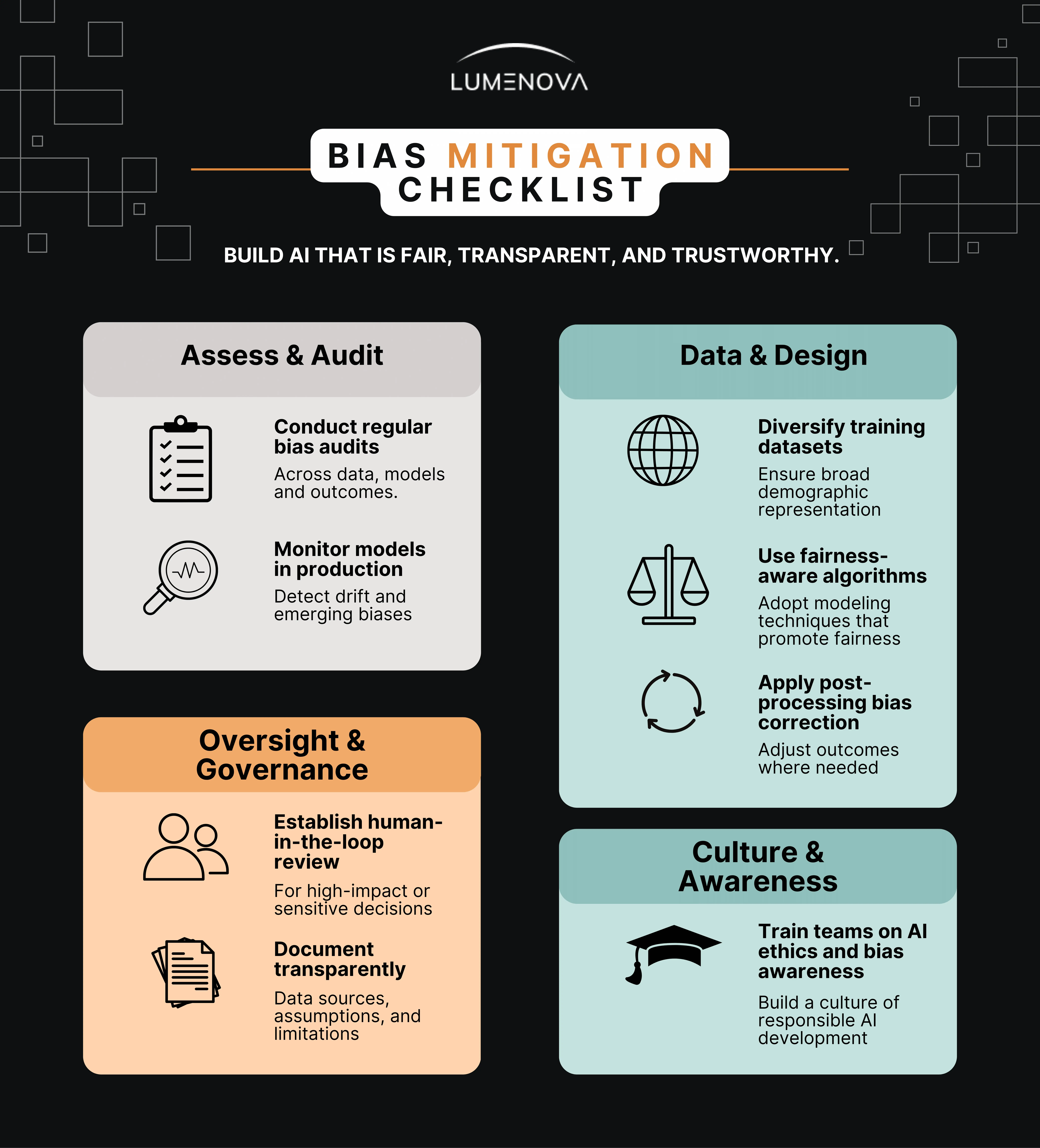
Contents
AI is transforming the way industries operate, from helping banks detect fraud to enabling faster medical diagnoses and automating claims processing in the insurance sector. While AI offers speed and scale, it also comes with a hidden risk: bias.
AI bias can quietly seep into systems and create inaccurate, unfair, or even harmful outcomes. Biases often reflect human and societal flaws embedded in data, design choices, and deployment practices. If left unchecked, they can erode trust and expose companies to regulatory and reputational risks.
For organizations developing autonomous AI systems and agents, the risks can become even more complex. As discussed in our article “The AI Revolution is Here”, keeping human oversight in the loop is critical to avoid compounding automation-related biases.
In this article, we will explore seven common types of AI bias, how they arise, and how they manifest in finance, healthcare, and insurance. Understanding these risks is the first step toward building more trustworthy and responsible AI.
The Regulatory Landscape
AI bias is no longer just a technical concern. It is rapidly becoming a compliance issue.
In the United States, the White House Blueprint for an AI Bill of Rights and recent FTC guidance emphasize fairness, transparency, and non-discrimination in automated systems. In Europe, the EU AI Act introduces risk-based requirements for data quality, documentation, and human oversight.
Financial regulators, health agencies, and insurance supervisors are also issuing guidance on AI governance. Companies that proactively identify and mitigate bias will be better positioned to meet evolving regulatory expectations and maintain public trust.
For a broader look at how AI risk management supports regulatory compliance, explore frameworks such as the NIST AI Risk Management Framework and the OECD AI Principles.
The 7 Common Types of AI Bias
1. Data Bias
AI models are only as good as the data they are trained on. If training data is skewed, incomplete, or unrepresentative, the model will produce biased results.
Example: An AI model trained on historical loan approvals that excluded minority applicants may unfairly deny credit today.
Why it matters: Data bias can cause models to systematically exclude or harm certain groups. Without careful data governance, biases will propagate at scale across critical decisions. Organizations should adopt structured bias assessment and data governance processes, following frameworks such as the NIST AI Risk Management Framework.
2. Algorithmic Bias
Bias can emerge from the model itself through how algorithms process input data, weigh variables, or prioritize certain outcomes. This can reflect the assumptions of the model’s designers or artifacts of its mathematical architecture.
Example: A recommendation engine may prioritize content that maximizes engagement, which can inadvertently amplify polarizing or harmful material.
Why it matters: Algorithmic bias can produce unexpected, opaque, and difficult-to-audit outcomes that are hard to correct after deployment. Designing with fairness in mind from the start is key. (Think skewed content recommendations, unfair credit scoring, or biased hiring tools.)
3. Selection Bias
When training datasets systematically exclude or underrepresent certain populations or scenarios, models fail to generalize effectively.
Example: Medical imaging datasets that predominantly feature light-skinned individuals can lead to lower diagnostic accuracy for patients with darker skin tones.
Why it matters: Selection bias reduces the generalizability and safety of AI systems in real-world environments. It also increases the risk of regulatory and legal exposure when underserved groups are harmed.
4. Automation Bias
Humans tend to over-trust automated systems, even when outputs are questionable. Automation bias leads users to accept AI decisions uncritically, especially in high-pressure environments.
Example: Doctors or underwriters relying on AI recommendations without adequate verification can propagate errors.
Why it matters: Automation bias can amplify the harms of other biases by embedding uncritical reliance on AI into workflows. Strong human-in-the-loop processes are essential to mitigate this risk and maintain accountability. (For example, in one documented case, radiologists deferred to AI suggestions and failed to detect subtle fractures that the AI had missed.)
5. Confirmation Bias
Developers or users may select data, interpret model results, or fine-tune systems in ways that confirm their own expectations or beliefs, whether intentionally or not.
Example: An AI tool for evaluating startup investments may be trained to prioritize factors favored by the venture capital firm, reinforcing existing patterns of who receives funding.
Why it matters: Confirmation bias hardens existing inequities and stifles innovation. It can also lead to the appearance of success in model validation while hiding underlying harms or performance gaps.
6. Societal Bias
AI systems can reflect systemic inequities in the societies they serve. If biased societal structures, such as redlining or employment discrimination, are encoded in historical data, models will reinforce these disparities.
Example: Predictive policing models trained on historical arrest data may disproportionately target communities of color.
Why it matters: Societal bias is one of the hardest forms of bias to detect and mitigate. It can lead to systemic discrimination at scale. The OECD AI Principles provide high-level guidance for addressing such systemic concerns and promoting inclusive AI development.
7. Reporting Bias
Reporting bias occurs when training data is drawn from sources that emphasize rare, extreme, or newsworthy events. This causes models to misrepresent reality and can skew decision-making.
Example: An AI system trained on sensationalized media reports of insurance fraud may wrongly overestimate its prevalence.
Why it matters: Reporting bias is one of the hidden risks that can undermine AI performance and fairness. As discussed in our article on AI Due Diligence in Mergers and Acquisitions, surfacing these types of risks early is essential to building trust in AI systems and ensuring they do not introduce unintended harm post-integration.
Want a broader understanding of bias in artificial intelligence? Our AI Glossary entry on Bias covers additional types and provides key definitions used in AI ethics, risk, and governance frameworks.
How AI Bias Manifests in Key Industries
Finance
Credit Scoring – Data and algorithmic bias in credit scoring can unfairly penalize minorities, women, and low-income individuals. Historical exclusion from financial systems leads to thin credit files, which perpetuates cycles of limited access.
Fraud Detection – Selection and automation bias can result in over-monitoring certain demographics or geographic areas while under-detecting fraud elsewhere.
Investment Algorithms – Confirmation bias can cause investment models to favor certain asset classes, sectors, or geographies that reflect the biases of fund managers.
Healthcare
Diagnostic Systems – Data and selection bias impact AI diagnostic tools because many are trained on datasets lacking demographic diversity. For instance, dermatology models may miss melanoma cases in patients with darker skin.
Treatment Recommendations – Algorithmic and societal bias can result in unequal treatment pathways. One well-documented case involved an algorithm prioritizing healthier white patients over sicker Black patients based on flawed proxies.
Patient Monitoring – Automation bias can cause clinicians to accept AI-generated alerts or recommendations without critical review, even when they conflict with clinical judgment.
Insurance
Underwriting – Data and societal bias can skew risk assessment models, which may lead to higher premiums or denial of coverage for historically marginalized groups.
Claims Processing – Reporting bias may distort claims models. If they are trained predominantly on large, complex claims, smaller but legitimate claims may be deprioritized.
Fraud Detection – Algorithmic bias may disproportionately flag claims from specific demographics as suspicious, which leads to unjust scrutiny and delays.
Bias Mitigation Checklist
- Conduct regular bias audits across data, models, and outcomes.
- Diversify training datasets to ensure broad demographic representation.
- Use fairness-aware algorithms and modeling techniques.
- Apply post-processing bias correction where needed.
- Establish human-in-the-loop review for high-impact decisions.
- Monitor models in production for drift and emerging biases (see our AI Security Tools Guide for additional techniques).
- Document data sources, assumptions, and limitations transparently.
- Train teams on AI ethics and bias awareness.

Key Takeaways
- AI bias is multifaceted and is not just a technical issue. Bias reflects systemic, social, and human factors as well.
- Context matters, because bias manifests differently in finance, healthcare, and insurance.
- Human oversight is critical. Automation bias must be mitigated by clear governance and review processes.
- Bias mitigation must be ongoing. Regular audits, diversified datasets, fairness-aware model design, and transparency all play vital roles.
For a practical framework on aligning bias mitigation with enterprise risk management, explore our article With Great Efficiency Comes Great Risk: Why AI and Risk Management Go Hand-in-Hand.
How Lumenova Can Help
Building AI that is fair, transparent, and responsible is no longer optional. Lumenova helps organizations proactively identify, measure, and mitigate AI bias across the entire model lifecycle. Our AI Risk & Governance platform integrates seamlessly with your AI development and operations, enabling continuous bias monitoring, compliance reporting, and human-in-the-loop governance.
Learn how Lumenova can help your organization build more trustworthy AI. Schedule a demo today.
Frequently Asked Questions
Societal bias is often the hardest to detect because it is embedded in historical data and social structures.
Audit at multiple stages, including during data collection, model training, pre-deployment validation, and post-deployment monitoring. Involve multidisciplinary teams, including ethics and compliance experts.
No. However, minimizing bias and ensuring models do not systematically harm vulnerable groups is both achievable and necessary. The goal is continuous improvement and responsible AI governance.